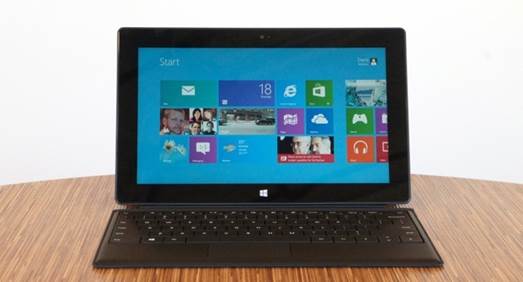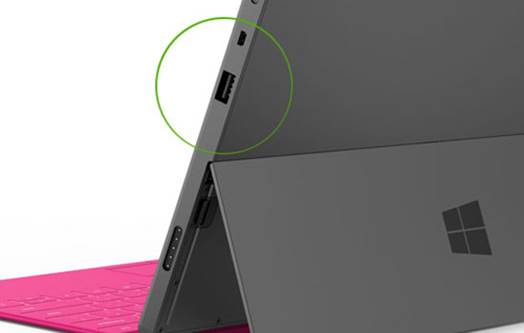Performance and battery life
Underneath it, the Surface runs on 2GB RAM
and a quad-core Nvidia Tegra T30 chip, the similar SoC power that powers
Windows RT tablets, like the Asus RT ViVoTab. Since we do not know any specific
examination only for this operating system, we will say this: the Tegra 3
processor is more than capable of handling the Live Tiles and Modern UI in
Windows RT. The tablet’s cold boot is under 25 seconds and launches applications
quickly. It reacts smoothly with tapping and swiping, and we also found that
the tablet responded quickly if you first opened the application, tapped the
home button and changed your mind before the application completed the loading.

The
Surface runs on 2GB RAM and a quad-core Nvidia Tegra T30 chip, the similar SoC
power that powers Windows RT tablets, like the Asus RT ViVoTab.
We noticed the occasional delays while swiping
from the left of the screen to switch between open applications. To clarify it,
no matter how many apps we had opened: in fact, we often forgot to count how
many applications were running. We rarely needed to close any application by
hand and the device never seemed to get worse as they are running on the background.
In summary, there are some performance limitations, but in general, the Surface
is fast and stable.
The only test we felt it was comfortably
running was the browser-based SunSpider JavaScript and did not care about the
platform. Here, the Surface has brought very good average score of 994ms. It is
almost twice faster than the newest iPad and almost as fast as the record
holder, the iPhone 5, which passed the test in 924ms when we evaluated it.
Indeed, the website shows the iPad was much faster at the beginning, with the
main content and text appearing soon. But if you waited for all the content to be
loaded, the total page load time is comparable between the two.
You may remember we said this computer has
powerful battery? How about nearly 10 hours? In our standard test for tablet battery,
including the loop of a video stored locally, Wi-Fi on and the brightness fixed
at 50%, the Surface’s 31.5Wh battery lasted 9 hours and 36 minutes, losing only
a bit to the new iPad (9 hours 52 minutes) and bypassing Asus’s high-end Transformer
Infinity Pad (at 9 hours 25 minutes).
Software

We
are still a little vague about the way Microsoft intends to educate consumers
about the differences between Windows RT and Windows 8.
To tell the truth: we are still a little vague
about the way Microsoft intends to educate consumers about the differences
between Windows RT (for devices based on ARM) and Windows 8 (for full x86 PCs),
especially because there will be many laptop / tablet hybrid products looking
the same to run on Windows 8. For example? The Surface with Windows
Professional, which was released a few months ago and more expensive than the RT,
but looked exactly the same, both on the outside and inside in the operating
system.
So, it is useful to start by addressing
some common misconceptions about Windows RT. First of all, contrary to what
some readers may believe, it has indeed a background screen, just like the normal
Windows. The taskbar is fitted with a variety of applications from Office Home
& Student 2013 RT: Word, Excel, PowerPoint and OneNote.
That is, you will not need to spend much
time on the screen, because Windows RT cannot run legacy programs written for
Windows systems based on traditional x86. In other words, while you can install
one application like Photoshop on a full Windows 8 computer, you cannot do that
here, as well as any other Windows applications written since the beginning of
the operating system. In addition, we doubt anyone will be bothered to write
desktop applications rather than applications optimized to run in the common Live
Tile interface.
However, the desktop could be a godsend gift
in some specific situations. First, the USB port something that fits perfectly
Windows RT. Although this is not "full" Windows, it still has
compatibility with almost any storage device or accessory power supply by the USB
you normally use with your Windows computer, a lot of legacy programs. It is really
interesting to plug a USB in and start dragging and dropping files. Or feel
free the comfortable keyboard that you used during the decade, or the HP
LaserJet printers are still working well after all these years. They are a
luxury that you can acquiesce, but would appreciate more when you start
comparing the Surface with other tablets. In short, the USB connection is not
only a specification or point that may be controversial: it means you can use
this Windows tablet as a PC, whenever it feels convenient for you.

The
USB port something that fits perfectly Windows RT.
Apart from the fact that Windows RT cannot
run legacy apps, it looks like Windows 8. As you surely know, there is no Start
button and Start Menu that consists of Live Tiles imitating what is there on Windows
Phone. Here, you will find all the usual applications naturally, such Mail,
Calendar, People, Camera and Internet Explorer 10. (There are 2 versions of IEs:
one on the screen, and a touch-friendly than exists as a Live Tile. They, at
least, share the same bookmark at the moment). The Desktop is also an app on
the Start screen. Furthermore, any similar gestures can still be applied: swiping
from the right to expose the Charm Bar, which contains the options to search
for content and adjust system settings. Swipe from left to switch apps and swipe
from above or below to view the options available for specific applications,
such as constantly playing video games. That the options are able to be hidden
means that some users will have to learn before they take their tablet, but
once they have mastered it, they will see the options and commands that are
often just some taps away from them.